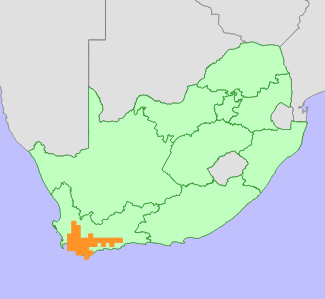|
Scientific Name | Leucadendron salicifolium (Salisb.) I.Williams |
Higher Classification | Dicotyledons |
Family | PROTEACEAE |
Synonyms | Leucadendron strictum R.Br. |
Common Names | Common Stream Conebush (e), River Conebush (e), Rivier-tolbos (a), Stream Conebush (e), Tolbos (a) |
National Status |
Status and Criteria | Least Concern |
Assessment Date | 2019/06/18 |
Assessor(s) | A.G. Rebelo, H. Mtshali & L. von Staden |
Justification | Leucadendron salicifolium is widespread and abundant. In spite of ongoing habitat loss and degradation, it is not yet in danger of extinction. |
Distribution |
Endemism | South African endemic |
Provincial distribution | Western Cape |
Range | Leucadendron salicifolium is widespread in the mountains of the Western Cape, where it occurs from the Groot Winterhoek Mountains southwards to the Kogelberg area, and eastwards along the coastal mountains to Bredasdorp. Inland it extends along the Riviersonderend and Langeberg Mountains to the Gourits River. |
Habitat and Ecology |
Major system | Terrestrial |
Major habitats | Hawequas Sandstone Fynbos, Swartland Alluvium Fynbos, Breede Sand Fynbos, Elim Ferricrete Fynbos, Boland Granite Fynbos, Breede Shale Fynbos, Elgin Shale Fynbos, Breede Alluvium Fynbos, Garden Route Shale Fynbos, Winterhoek Sandstone Fynbos, Kogelberg Sandstone Fynbos, Overberg Sandstone Fynbos, North Sonderend Sandstone Fynbos, South Sonderend Sandstone Fynbos, North Langeberg Sandstone Fynbos, South Langeberg Sandstone Fynbos, Greyton Shale Fynbos |
Description | It occurs in sandy soils and seeps near streams in lowland and montane fynbos, 0-1000 m. Mature individuals are killed by fires, and only seeds survive. Seeds are stored in fire-resistant inflorescences, and released after fires. It is dioecious, with wind-pollinated male and female flowers occurring on separate plants. |
Threats |
| About 24% of this species' habitat is already irreversibly modified, predominantly due to historical habitat loss to agricultural expansion on lowland alluvial soils in the Breede River Valley, Koue Bokkeveld and Berg River Valley. There is slow, ongoing habitat loss, but since the majority of this species' habitat is in montane areas unsuited to cultivation, overall habitat loss is about 2% in 24 years.
Currently, it is threatened by competition from alien invasive plants that are spreading and increasing in density in the Riviersonderend, Langeberg, Hawequas and Kleinrivier Mountains, as well as groundwater extraction in the Hottentots Holland and Kogelberg mountains. Increasing prolonged droughts in the Western Cape are increasing pressure on groundwater resources, on which this seep-preferring species is dependent. |
Population |
Leucadendron salicifolium is an abundant species, occurring in dense, extensive stands (Rebelo 2001). There is ongoing, slow population decline due to habitat loss and degradation, but it is very unlikely that population reduction will exceed 15% in three generations.
|
Population trend | Decreasing |
Assessment History |
Taxon assessed |
Status and Criteria |
Citation/Red List version | | Leucadendron salicifolium (Salisb.) I.Williams | Least Concern | Raimondo et al. (2009) | |
Bibliography |
Goldblatt, P. and Manning, J.C. 2000. Cape Plants: A conspectus of the Cape Flora of South Africa. Strelitzia 9. National Botanical Institute, Cape Town.
Raimondo, D., von Staden, L., Foden, W., Victor, J.E., Helme, N.A., Turner, R.C., Kamundi, D.A. and Manyama, P.A. 2009. Red List of South African Plants. Strelitzia 25. South African National Biodiversity Institute, Pretoria.
Rebelo, T. 2001. Sasol Proteas: A field guide to the proteas of southern Africa. (2nd ed.). Fernwood Press, Vlaeberg, Cape Town.
Vlok, J. and Schutte-Vlok, A.L. 2010. Plants of the Klein Karoo. Umdaus Press, Hatfield.
|
Citation |
| Rebelo, A.G., Mtshali, H. & von Staden, L. 2019. Leucadendron salicifolium (Salisb.) I.Williams. National Assessment: Red List of South African Plants version . Accessed on 2025/06/28 |
 Comment on this assessment
Comment on this assessment

